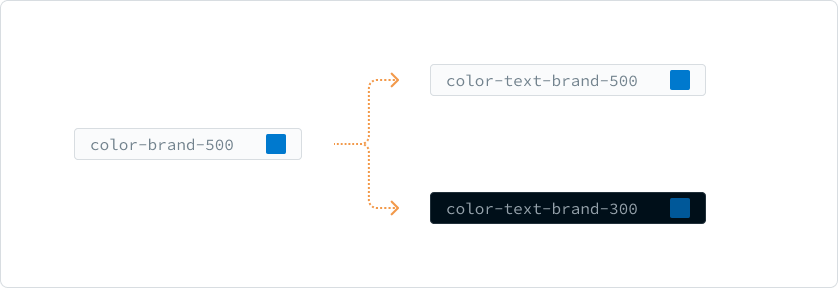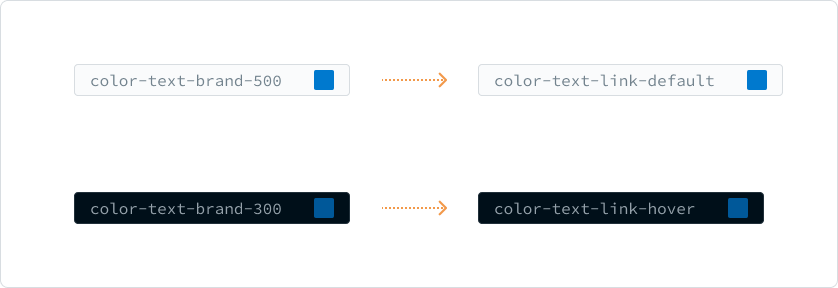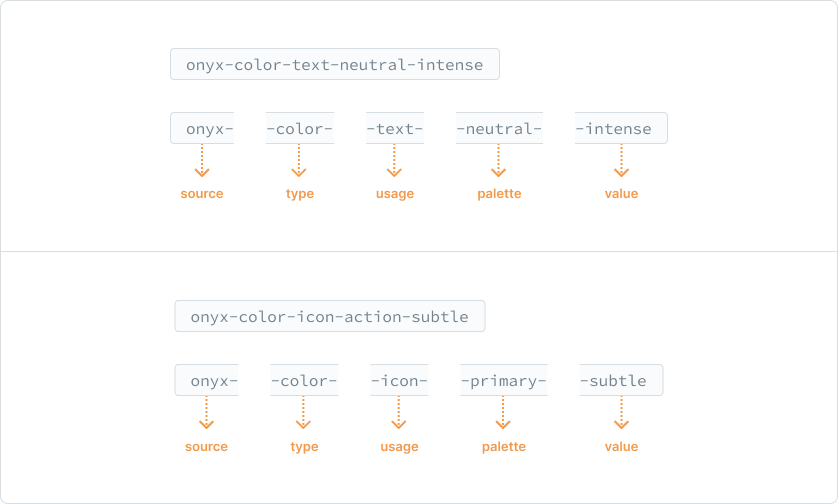Introduction
Understanding the logic, structure and usage of variables is crucial for creating onyx applications. Here is everything you need to know. Please feel free to visit our Q&A if you have any questions.
What is a design variable?
A design variable is a fundamental, reusable building block for design systems like onyx. It represents a specific aspect of a design as a key-value pair such as color, typography, spacing or another visual element. Design variables help maintain consistency and streamlining the design and development process across various platforms and applications.
Important
Design variables are used equally in development and design to ensure the customizability under the consideration of the consistency across all onyx applications.
How do they work?
First of all, it is essential to understand the basic systematic of variables. Variables are categorized into three layers, that are related to each other. Every variable layer has its own responsibility, but not all layers are used directly in the design and development process.
Global variables
Global variables are the fundamental elements of every design system to establish a unique design language. This level of variables define fundamental properties such as colors, spacings and other without any use case or context. All of those values are stored in a systematic way.
For example onyx-color-universal-white is just the value for white color in general.
Important
Global variables are not used within the process of designing and developing an application! As a result they are hidden to minimize sources of errors. Imagine them like the invisible base for your product.

Semantic variables
This variable layer puts the global variables into context. At this point, semantic variables differentiate between light and dark mode and connect a use case or purpose to the values, that were defined in the global variables. The naming of semantic variables is less generic and more specific to the intended use.
For example onyx-color-surface-bg-blank is exclusively used for a blank background color. To have a more detailed view about the color variable system and how light and dark modes are implemented, please check out the color documentation.
Important
Semantic variables are used from both developers and designers to build applications with existing standard components. With the use of those variables, a seamless switch between light and dark mode is guaranteed. Otherwise, this will not work without additional effort.

Component variables
The third and last variable layer is used for building components exclusively. Important to know is: To keep things simple, not every component is built with component variables. They are only used in case of irregularities or exceptions between the provided color themes.
For example onyx-component-button-primary-bg-hover is exclusively used for the hover effect color of the onyx primary button.
Important
Only the maintainers (onyx designers and developers) of the design system are able to use component variables on a regular basis. All others do not have access to minimize sources of errors. Instead all application-designers and -developers do benefit from component variables by using standard onyx components in their project.

Why is it important?
In essence, design variables provide a systematic and efficient way to abstract and manage visual design attributes, fostering coherence and flexibility in the creation and maintenance of digital products and user interfaces. Here are the key benefits:
Consistency
Design variables help maintain a consistent look and feel across different components and elements of a design system. By using predefined values for colors, typography, spacing, and other design elements, you ensure a cohesive visual identity throughout your project.
Scalability
As a project grows in size and complexity, design variables make it easier to scale design efforts. When changes are needed, such as updating a color or a font, design variables allow for quick and systematic adjustments across the entire system.
Collaboration
Design variables facilitate collaboration between designers and developers. By using a shared set of design variables, both teams can work more seamlessly together. Designers can focus on creating consistent designs, while developers can easily implement those designs using the predefined variables.
Maintenance
Design variables simplify the maintenance process. If a design element needs to be updated or changed, you can do so by modifying the corresponding design variable, ensuring that the change is reflected consistently across the entire project.
Adaptability
Design variables enhance adaptability across different platforms and devices. Whether you're designing for a website, mobile app, or other digital platforms, using design variables allows for easier adaptation and consistency across various screen sizes and resolutions.
Efficiency
Design variables promote efficiency in the design and development workflow. Designers can create and update designs more quickly, and developers can implement changes more efficiently, reducing the overall time and effort required for both disciplines.
Documentation
Design variables serve as a form of documentation for the design system. They provide a clear and structured reference for all the design elements, making it easier for team members to understand and use the design system effectively.
How to read variables?
onyx uses a strict naming convention for the variables to keep consistency. For a better understanding of the naming convention, see the information below.
TIP
Design variables of the onyx design system are always prefixed with onyx- so they can always be differentiated with custom variables of your application.
To get more details about the color palette system and the transmission into the variable system (considering light and dark mode), please visit the color documentation.

